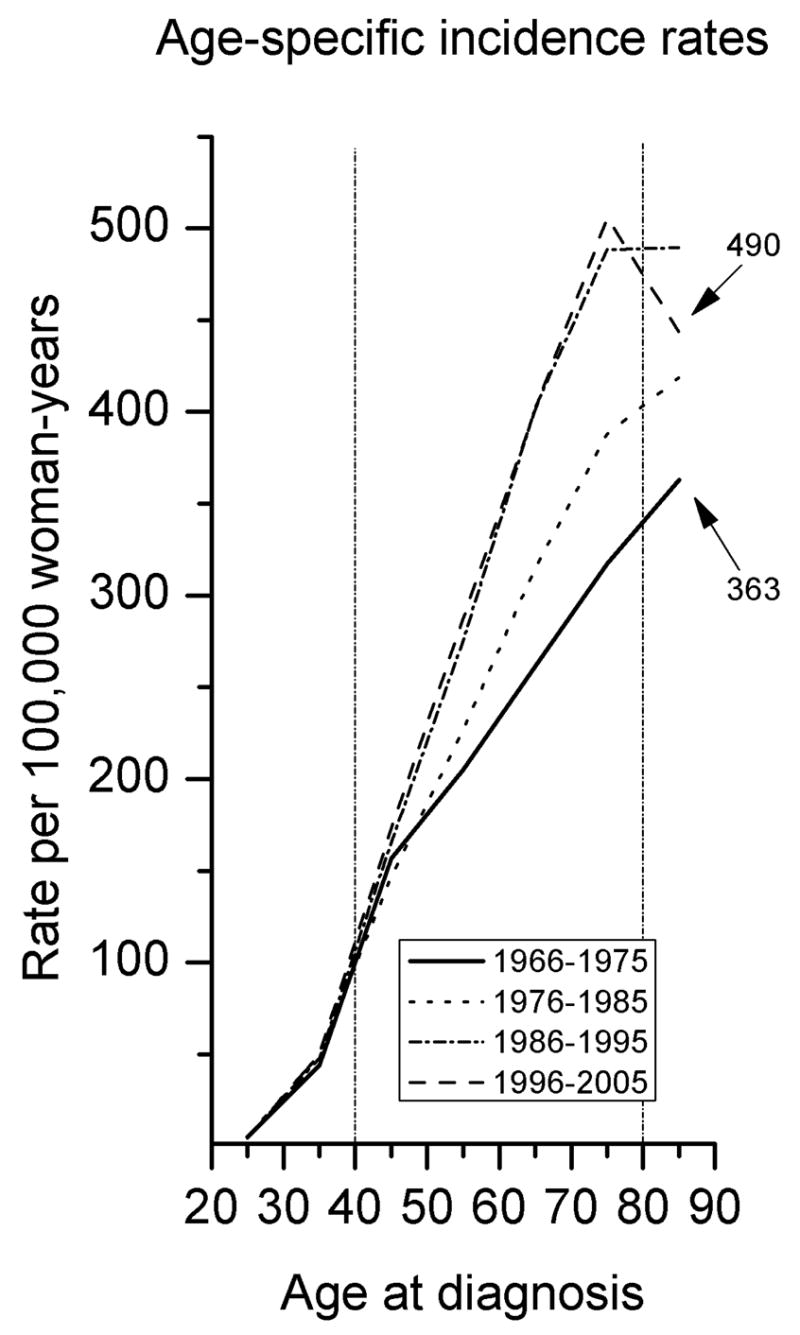Zahl et al’s study in four Norwegian counties suggests that some of the occult invasive breast cancers detected by mammography screening might ultimately have undergone spontaneous regression (1). Population-based statistics in the United States support this hypothesis as well (2). Indeed, since the advent of mammography screening, age-specific breast cancer incidence rates in Europe have increased dramatically among women in those age groups targeted for screening (3). For example, in many western European countries, systematic screening programs were introduced in the late 1980s and early 1990s for women aged 50–69, and this was followed by sharp increases in the incidence of invasive breast cancer in these women (3). This trend is also observed in the United States, as illustrated in figure 1, using data from the Connecticut Historical database of the National Cancer Institute’s Surveillance, Epidemiology, End Results (SEER, http://seer.cancer.gov/) program. This figure shows that, since the late 1970s, with increasing utilization of mammography screening among women aged 40–80, age-specific incidence rates for this age group have increased from their baseline rate during 1966 to 1975.
Figure 1.

Although mammography screening might be expected to transiently increase the incidence of invasive breast cancer, assuming constant risks, it should also ultimately result in a corresponding decrease in invasive cancer incidence among the elderly. Yet the Connecticut data indicate that, in the elderly population, incidence rates for invasive breast cancers during the latest time period (490 per 100,000 woman-years in 1996–2005) has not dropped below the baseline rate prior to the advent of mammography screening (363 per 100,000 woman-years in 1966–2005), figure 1. Similar incidence patterns have also been observed in Europe (3). Taken together, these incidence patterns might be interpreted to mean that mammography screening results in a significant diagnosis of occult, non-lethal invasive breast cancers. Furthermore, the improved prognosis of screen-detected cancers, as described by Shen et al. and Joensuu et al, might partly be attributable to the effects of this over-diagnosis (4, 5).
It has long been accepted that mammography screening results in a significant over-diagnosis of ductal carcinoma in situ (DCIS) (6). We must now accept the possibility that screening may result in the over-diagnosis of occult, non-lethal invasive breast cancers as well. Newer screening technology (such as digital mammography and magnetic resonance imaging) may further increase the detection rate of these occult, non-lethal invasive cancers.
References
- 1.Zahl PH, Maehlen J, Welch HG. The natural history of invasive breast cancers detected by screening mammography. Arch Intern Med. 2008;168(21):2311–2316. doi: 10.1001/archinte.168.21.2311. [DOI] [PubMed] [Google Scholar]
- 2.Anderson WF, Jatoi I, Devesa SS. Assessing the impact of screening mammography: breast cancer incidence and mortality rates in Connecticut (1943–2002) Breast Cancer Res Treat. 2006;99:333–340. doi: 10.1007/s10549-006-9214-z. [DOI] [PubMed] [Google Scholar]
- 3.Hemminki K, Bermejo JL. Effects of screening for breast cancer on its age-incidence relationships and familial risk. Int J Cancer. 2005;117(1):145–9. doi: 10.1002/ijc.21149. [DOI] [PubMed] [Google Scholar]
- 4.Shen Y, Yang Y, Inoue LYT, Munsell MF, Miller AB, Berry DA. Role of detection method in predicting breast cancer survival: analysis of randomized screening trials. J Natl Cancer Inst. 2005;97:1195–1203. doi: 10.1093/jnci/dji239. [DOI] [PubMed] [Google Scholar]
- 5.Joensuu H, Lehtimaki T, Holli K, Elomaa L, Turpeenniemi-Hujanen T, Kataja V, et al. Risk for distant recurrence of breast cancer detected by mammography screening or other methods. JAMA. 2004;292(9):1064–73. doi: 10.1001/jama.292.9.1064. [DOI] [PubMed] [Google Scholar]
- 6.Jatoi I, Baum Mammographically detected ductal carcinoma in situ: are we overdiagnosing breast cancer? Surgery. 1995;118 (1):118–120. doi: 10.1016/s0039-6060(05)80019-4. [DOI] [PubMed] [Google Scholar]


